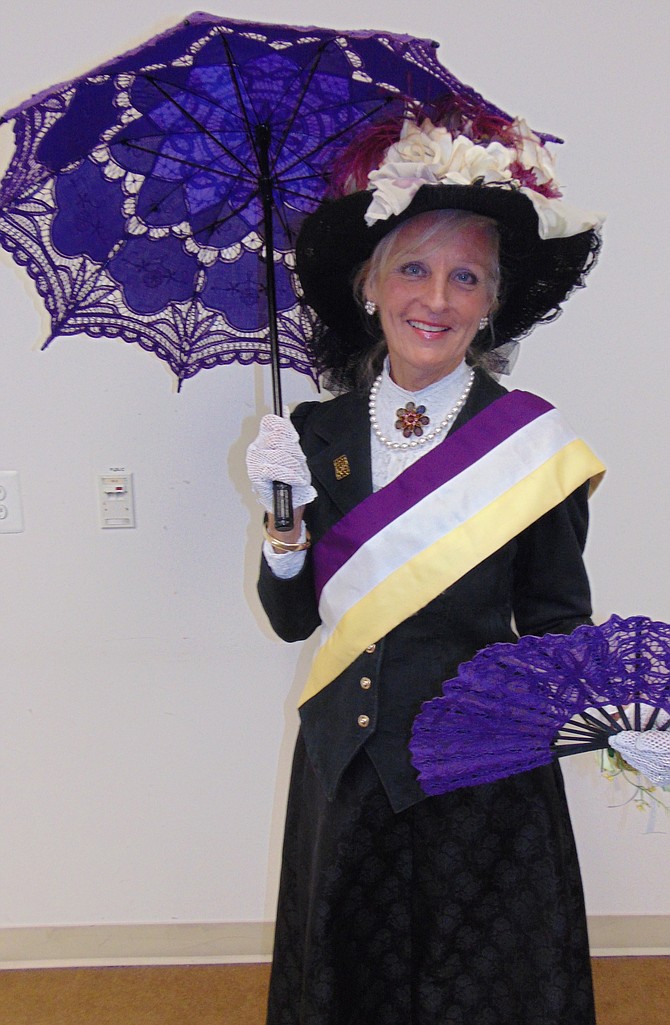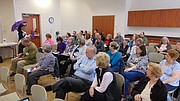Lynne Garvey-Hodge gave a lecture on Forgotten Fairfax: 100th Anniversary of the Night of Terror at the Fairfax City Regional Library on Saturday, Nov. 4, 2017. Photo by Steve Hibbard.
Commemorating the Night of Terror
To help commemorate the Night of Terror, next Sunday, Nov. 12, 2017, at 1:30 p.m., the Lorton Arts Center will host the Night of Terror — A Centennial Commemoration. The event is free with a suggested donation of $19.17. It is sponsored by the Workhouse Arts Center Prison Museum and Turning Point Suffragist Memorial Association. The address is 9518 Workhouse Road, Lorton.
Local historian Lynne Garvey-Hodge of Clifton gave a lecture last Saturday on Forgotten Fairfax: 100th Anniversary of the Night of Terror at the Fairfax City Regional Library.
The talk centered on the 32 female protesters, known as "Silent Sentinels," who picketed the Woodrow Wilson White House on Nov. 14, 1917, for the right to vote and were then incarcerated, beaten, chained, and force-fed at the Occoquan Workhouse in Lorton.
"I am delighted that the Fairfax City Library is promoting these kinds of history talks because there is so much rich history that reflects the United States and this area right here in our own back yards, and if we don't come and listen to it and we don't participate in it, we will lose all of that," said Garvey-Hodge, who has served seven terms on the Fairfax County History Commission.
"We do these lectures to give the public more of an awareness of these forgotten or often overlooked or little-known topics of Fairfax County's history," said Chris Barbuschak, City of Fairfax librarian and archivist. While 50 people attended, he said this is the second-annual lecture series, which are talks on Virginia Room sponsors of the local history and genealogy part of the library.
While dressed as a society lady with parasol and fan, and re-enacting the role of Mrs. Robert Walker, Garvey-Hodge told the story of suffragists Alice Paul and Lucy Burns who coordinated a parade with 8,000 women championing the right to vote before the inauguration of President Woodrow Wilson in Washington. She said most of the parade spectators were men who spit and threw eggs and tomatoes at them. They held another parade with 10,000 women a month later.
TO MAKE IT KNOWN that they would not be silent, the women began picketing in 1917 in front of the White House; they were an embarrassment to Wilson, so they were fined $25 for obstructing traffic and taken to the Washington, D.C., jail for two days. After a mock trial, they were found guilty and sent to Occoquan Workhouse in Lorton, where the conditions were deplorable.
While in prison, Garvey-Hodge said their clothes, jewelry, and shoes were taken from them. They were given crude prison uniforms to wear and a blanket that smelled of vomit and urine. Their cell beds were covered in bed bugs and for food, they were given soup infested with worms and dirty water to drink. In response, the women held hunger strikes, and were then put in straitjackets and force-fed through tubes. In addition, the Negro girls in prison were ordered to beat up on the suffragists to keep an insurrection from happening.
In a slide show presentation, Garvey-Hodge shared stories of women suffragists including Lucy Burns, Dora Lewis, and Mary Nolan, who were taken to prison and given 6-90 days depending on their arrests. The picketing began in January and the arrests started in June.
On Nov. 27-28, 1917, all the imprisoned suffragists were released from Occoquan Workhouse. Journalists put the prisoners' ill treatment on the front page of newspapers across the U.S., which was an embarrassment to Wilson. On Dec. 9, 1917, Garvey-Hodge said that some 4,000 suffragists gathered and celebrated their devotion to the cause.
But it would still take two more years for women to get the right to vote as Wilson turned the issue over to 36 states. So in 1919 and 1920, the suffragists went on parades and held demonstrations for the cause. On Aug. 18, 1920, the woman's right to vote came down to one individual — Harry Burn, a Senator from Tennessee. Garvey-Hodge said on the night before the vote, his mother sent him a letter urging him to do the right thing and vote for the 19th Amendment. With his vote, Alice Paul, who co-founded the Congressional Union and then formed the National Woman’s party, sewed the 36th star that made the 19th Amendment the law of the land. Twelve states west of the Mississippi supported women's right to vote in the early days; the support from Eastern states came later.
GARVEY-HODGE ended her talk with these final thoughts: "I have a dream that someday, someday we'll have women Governors in this land, that half of Congress may be women, that we may some day have a woman in the White House. This land is about freedom for all, freedom for everyone. ... My hope for you is that never, any of you, should have to wake up some day and say to your daughter, your sister, your aunt, your grandmother, you should never have to say, Mr. President, how long must women wait for liberty?"
Garvey-Hodge also pointed out that the 19th Amendment wasn't accepted in Commonwealth of Virginia until the year 1952.

